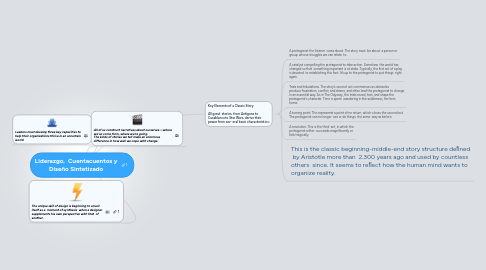Liderazgo, Cuentacuentos y Diseño Sintetizado
by Gabriel Sousa

1. Key Elements of a Classic Story All great stories, from Antigone to Casablanca to Star Wars, derive their power from sev- eral basic characteristics:
1.1. A protagonist the listener cares about. The story must be about a person or group whose struggles we can relate to.
1.2. A catalyst compelling the protagonist to take action. Somehow the world has changed so that something important is at stake. Typically, the first act of a play is devoted to establishing this fact. It’s up to the protagonist to put things right again.
1.3. Trials and tribulations. The story’s second act commences as obstacles produce frustration, conflict, and drama, and often lead the protagonist to change in an essential way. As in The Odyssey, the trials reveal, test, and shape the protagonist’s character. Time is spent wandering in the wilderness, far from home.
1.4. A turning point. This represents a point of no return, which closes the second act. The protagonist can no longer see or do things the same way as before.
1.5. A resolution. This is the third act, in which the protagonist either succeeds magnificently or fails tragically.
1.6. This is the classic beginning-middle-end story structure defined by Aristotle more than 2,300 years ago and used by countless others since. It seems to reflect how the human mind wants to organize reality.
2. Leaders must develop three key capacities to help their organizations thrive in an uncertain world.
3. All of us construct narratives about ourselves—where we’ve come from, where we’re going. The kinds of stories we tell make an enormous difference in how well we cope with change.
4. The unique skill of design is beginning to unveil itself as a moment of synthesis when a designer supplements his own perspective with that of another.


